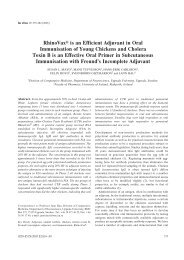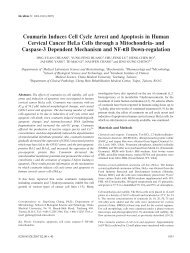Leukocyte and Endothelial Cell Adhesion Molecules in Inflammation ...
Leukocyte and Endothelial Cell Adhesion Molecules in Inflammation ...
Leukocyte and Endothelial Cell Adhesion Molecules in Inflammation ...
You also want an ePaper? Increase the reach of your titles
YUMPU automatically turns print PDFs into web optimized ePapers that Google loves.
Golias et al: <strong>Adhesion</strong> <strong>Molecules</strong> <strong>in</strong> Inflammatory Heart Disease (Review)<br />
Table I. Soluble cell adhesion molecules (sCAMs) <strong>in</strong>volved <strong>in</strong> leukocyte-endothelial cell adhesion. Localization <strong>and</strong> function of sCAMs.<br />
<strong>Adhesion</strong> molecule Localization Function<br />
Select<strong>in</strong> family<br />
L-Select<strong>in</strong> All leukocytes Roll<strong>in</strong>g<br />
P-Select<strong>in</strong> <strong>Endothelial</strong> cells <strong>and</strong> platelets Roll<strong>in</strong>g<br />
E-Select<strong>in</strong> <strong>Endothelial</strong> cells Roll<strong>in</strong>g<br />
Ig gene Superfamily<br />
ICAM-1 Endothelium <strong>and</strong> monocytes Adherence/migration<br />
ICAM-2 Endothelium Adherence/migration<br />
ICAM-3 All rest<strong>in</strong>g leukocytes Adherence/migration<br />
VCAM-1 Endothelium Adherence<br />
PECAM-1 Endothelium, leukocytes, platelets Adherence/migration<br />
MAdCAM-1 Endothelium (<strong>in</strong>test<strong>in</strong>e) Adherence/migration<br />
Select<strong>in</strong>s. Select<strong>in</strong>s are lect<strong>in</strong>-like b<strong>in</strong>d<strong>in</strong>g prote<strong>in</strong> molecules<br />
that mediate the <strong>in</strong>itial low aff<strong>in</strong>ity leukocyte-endothelial<br />
cell <strong>in</strong>teraction that is manifested as leukocyte roll<strong>in</strong>g<br />
(Figure 1, Table I). This transient b<strong>in</strong>d<strong>in</strong>g results <strong>in</strong> further<br />
leukocyte activation <strong>and</strong> subsequent firm adhesion <strong>and</strong><br />
transendothelial migration of leukocytes (8, 20-22).<br />
Specifically, select<strong>in</strong>s are implicated <strong>in</strong> heterotypic<br />
<strong>in</strong>teractions between blood cells <strong>and</strong> endothelial cells dur<strong>in</strong>g<br />
leukocyte migration <strong>and</strong> firm adhesion (23). Their role is<br />
manifested dur<strong>in</strong>g the <strong>in</strong>itial adherence of the circulat<strong>in</strong>g<br />
leukocytes to the vascular wall that follows their roll<strong>in</strong>g as<br />
a response to an <strong>in</strong>fective or a carc<strong>in</strong>ogen mechanism.<br />
Additionally, as a response to <strong>in</strong>fection mediators, leukocyte<br />
gather<strong>in</strong>g is considered to be crucial for the adequate<br />
defence of the organism to any k<strong>in</strong>d of <strong>in</strong>jury or <strong>in</strong>fection.<br />
There are three closely related members of the select<strong>in</strong><br />
family each expressed on leukocytes (L-select<strong>in</strong>),<br />
endothelial cells (E-select<strong>in</strong>, P-select<strong>in</strong>) <strong>and</strong> platelets (Pselect<strong>in</strong>)<br />
(23). Each member conta<strong>in</strong>s a N-term<strong>in</strong>al C-type<br />
lect<strong>in</strong> doma<strong>in</strong> (carbohydrate recognition doma<strong>in</strong>), followed<br />
by an epidermal growth factor-like (EGF) motif, vary<strong>in</strong>g<br />
numbers of short consensus repeats similar to those found<br />
<strong>in</strong> complement regulatory prote<strong>in</strong>s (CRP), a<br />
transmembrane doma<strong>in</strong>, <strong>and</strong> a short cytoplasmic tail (Figure<br />
1) (24). Studies us<strong>in</strong>g chimeric select<strong>in</strong>s <strong>in</strong>dicate that both<br />
the lect<strong>in</strong> <strong>and</strong> the EGF doma<strong>in</strong>s are directly <strong>in</strong>volved <strong>in</strong> cell<br />
adhesion <strong>and</strong> may determ<strong>in</strong>e the specificity of lig<strong>and</strong><br />
b<strong>in</strong>d<strong>in</strong>g (25).<br />
In contrast to most of the other CAMs the role of select<strong>in</strong><br />
is strictly restricted to the <strong>in</strong>teractions between leukocytes<br />
<strong>and</strong> the vascular endothelium. In general, select<strong>in</strong>s share an<br />
important role <strong>in</strong> human physiology. In leukocyte adhesion<br />
deficiency II syndrome (LAD II), where select<strong>in</strong> lig<strong>and</strong>s are<br />
absent there is an <strong>in</strong>ability to recruit neutrophils <strong>in</strong>to sites of<br />
<strong>in</strong>flammation so that they cannot fulfil their role as effector<br />
cells <strong>in</strong> the immune system (26). Soluble circulat<strong>in</strong>g forms<br />
of the select<strong>in</strong>s can be detected <strong>in</strong> plasma, where elevated<br />
levels have been reported <strong>in</strong> serum of animals <strong>and</strong> patients<br />
with <strong>in</strong>flammatory diseases (27).<br />
P-select<strong>in</strong> (also known as CD62P or GMP-140 or<br />
PADGEM) is stored <strong>in</strong> specific granules present <strong>in</strong> platelets<br />
<strong>and</strong> endothelial cells (Weibel-Palade bodies) from where it<br />
can be rapidly mobilized to the cell surface <strong>in</strong> response to a<br />
variety of <strong>in</strong>flammatory agents such as thromb<strong>in</strong>, histam<strong>in</strong>e<br />
complement factors, free radicals <strong>and</strong> cytok<strong>in</strong>es (25, 28). <strong>Cell</strong><br />
surface expression of P-select<strong>in</strong> is generally short-lived<br />
(m<strong>in</strong>utes), which makes it an ideal c<strong>and</strong>idate for mediat<strong>in</strong>g<br />
early leukocyte-endothelial <strong>in</strong>teractions. Lig<strong>and</strong> for P-select<strong>in</strong><br />
is considered to be the P-select<strong>in</strong> glycoprote<strong>in</strong> lig<strong>and</strong>-1<br />
(PSGL-1) (29, 30). PSGL-1 undergoes special glycosylation<br />
<strong>in</strong> order to function as a lig<strong>and</strong>. P-select<strong>in</strong> also mediates<br />
neutrophil <strong>and</strong> monocyte adherence to stimulated<br />
thrombocytes <strong>and</strong> stimulated endothelial cells. Additionally,<br />
it mediates the <strong>in</strong> vitro capture of stimulated B-cells together<br />
with a subpopulation of T-cells <strong>in</strong> the stimulated<br />
endothelium. E-select<strong>in</strong> (CD62E, ELAM-1) is expressed by<br />
cytok<strong>in</strong>e-activated endothelial cells (29, 30).<br />
E-select<strong>in</strong> mediates the adhesion of neutrophils,<br />
monocytes <strong>and</strong> some memory T-cells to the vascular<br />
endothelium <strong>and</strong> may function as a tissue specific hom<strong>in</strong>g<br />
receptor for T-cell subsets (25). It is broadly expressed<br />
with<strong>in</strong> the vasculature at sites of <strong>in</strong>flammation. Additionally,<br />
it is found <strong>in</strong> arthritic jo<strong>in</strong>ts, <strong>in</strong> heart <strong>and</strong> renal allograft<br />
undergo<strong>in</strong>g rejection, <strong>and</strong> <strong>in</strong> cutaneous vessels of <strong>in</strong>flamed<br />
sk<strong>in</strong> with psoriasis, contact dermatitis <strong>and</strong> delayed type<br />
hypersensitivity reactions (25). E-select<strong>in</strong> is found <strong>in</strong> a<br />
biologically active form <strong>in</strong> serum, as a result of proteolytic<br />
cleavage from the cell surface (31, 32). Many lig<strong>and</strong>s for<br />
E-select<strong>in</strong> have been reported <strong>and</strong> are expressed by<br />
neutrophils, monocytes <strong>and</strong> lymphocytes, such as ESL-1<br />
lig<strong>and</strong> (E-select<strong>in</strong> lig<strong>and</strong>-1)(30) <strong>and</strong> PSGL-1 (P-select<strong>in</strong><br />
glycoprote<strong>in</strong> lig<strong>and</strong>-1) (30). Although there is no preformed<br />
759






